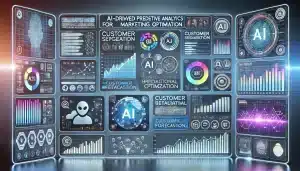In today’s fast-paced digital landscape, businesses are continually seeking innovative ways to enhance their marketing strategies. AI-driven predictive analytics has emerged as a powerful tool that allows marketers to harness data insights, forecast consumer behavior, and optimize their campaigns. This article explores the intricacies of AI-driven predictive analytics, its role in marketing strategy optimization, the tools available, the challenges faced during implementation, and future trends that marketers should be aware of.
What is AI-Driven Predictive Analytics in Marketing?
Understanding Predictive Analytics
Predictive analytics is built based on past history data, statistical algorithms, and machines using learning techniques to identify probabilities of certain future outcomes based on past behavior. It makes it easier for a brand to make data-informed decisions that will eventually lead to better customer engagement and higher conversion rates. Market analysis with purchase history, interaction on different websites, and demographic data help marketers gain insight into the prediction of the tendencies of the customer regarding potential action. It is more empowering in business decision-making and gives them a better perception of market trends and the needs of consumers.
The Role of AI in Marketing
Artificial intelligence transformed marketing by offering marketers multiple tools for automation that can process several pieces of data in unrelentingly short time frames. It can identify patterns and associations from datasets that even the best analysts may otherwise find difficult to note. Such is its capability that marketers can design very bespoke marketing initiatives based on actual insight in time. For example, artificial intelligence can track every customer‘s interactions across multiple platforms with relative ease, making it easy for brands to build targeted marketing campaigns which then generates engagement and loyalty.
Benefits of Combining AI and Predictive Analytics
The fusion of AI and predictive analytics benefits a marketer in many ways. For example, it aids in the proper optimization of a marketing strategy through the accurate forecasting of consumer behavior. It also gives an organization the chance to identify trends when they are still in their infancy, thus giving these organizations a chance to gain competitive advantages. Data analysis can automatically be made by marketers, freeing up their time and money. They would then be able to have enough time and be able to venture into strategic initiatives rather than doing heavy calculations. Furthermore, AI-driven predictive analytics improves customer segmentation. Customers will now be guided through marketing actions, which might result in even higher conversion rates.
How Can AI-Driven Predictive Analytics Optimize Marketing Strategies?
Identifying Target Audiences Effectively
One of the biggest advantages of AI-driven predictive analytics is that target audience profiling becomes easier. In these cases, marketers will have data and inputs from various touchpoints, including social media interactions and purchase histories. It can then be used to accurately form a customer profile in a very detailed manner. The profiles then help in stratifying the audience into segments that have common features, preferences, and behaviors. This granular level is where brands can calibrate their messaging and offers to reach the right audience, leading to higher engagement rates and customer satisfaction.
Improving Customer Segmentation
Predictive AI analytics enhance customer segmentation by making use of clustering algorithms that categorize consumer behavior based on complex behavioral patterns. Unlike ordinary demographics, this helps marketers understand what motivates their customers and what they would love. By incorporating these sophisticated segmentation techniques, the businesses can create more relevant marketing programs more relevant to each segment and thus enhance customer retention and loyalty. In addition, as customer information changes, AI systems can continue to fine-tune the segments, ensuring that marketing strategies continuously remain relevant and effective in a dynamic market environment.
Enhancing Campaign Performance
The marketer can optimize multiple elements about their marketing campaigns through predictive analytics ran by AI thereby letting go of the guesswork by testing different variables such as messaging, timing, and channels that would give a good result. Predictive nature allows for its real-time adjustments that can help bring about the greatest impact. Predictive analytics can also predict future campaign performance based on historical data, thus help marketers better allocate resources and avoid wasting them on underperforming strategies.
What Tools and Technologies Are Used for AI-Driven Predictive Analytics?
Popular Software Solutions
In the market, many software solutions are also emerging that are forcing marketers to match up with the implementation of AI-driven predictive analytics. The most popular tools include Salesforce Einstein, IBM Watson Analytics, and Google Analytics 4, which provide strong functionalities for marketers to analyze data, generate insights, and build predictive models. These also have user-friendly interfaces that even an individual having minimum technical knowledge will be able to use. Through these aids, companies can exploit AI and predictive analytics without requiring a lot of in-house support.
Integrating AI Tools with Existing Systems
The biggest way of getting the utility out of predictive analytics is through getting AI tools integrated with existing marketing systems. Organisations must also identify their sources of data, whether in the CRM or the content management platforms, and ensure they are supportive of AI technologies. The flow of data then becomes smooth, and marketers can use the potential of AI to understand everything about the interchange with customers. Integration can also be made easier with the use of APIs and cloud-based solutions, where businesses may not experience large business operations disruptions as they embrace new technologies.
Evaluating Tool Effectiveness
Marketers must regularly measure whether the AI-driven predictive analytics tools are really adding value. Checking frequently the KPIs of conversion rates, customer acquisition costs, and ROI in detail will let marketers understand if their predictive models are accurate and the insights created are actionable. Continuous assessment and adjustment of tools will enable organizations to enjoy constant competitiveness in the ever-changing marketing environment.
What Challenges Do Marketers Face When Implementing AI-Driven Predictive Analytics?
Data Quality and Accessibility
Data quality and availability is the most significant challenge marketers confront when implementing AI-driven predictive analytics. Incorrect or partial data could lead to misleading insight, eventually implemented into the marketing strategy. Marketers must invest in data cleansing and validation processes for overall high-quality data. Another major issue for organizations is the problem of data silos. These data silos prevent access to necessary information and, ultimately in the long term, create problems in the making of an omnidimensional view of customer behavior. All these demand a strategic approach towards data management and collaboration across the departments.
Key skill gaps within the marketing team
The advancement pace of AI technologies has introduced skill gaps in most marketing teams. Not all marketing professionals are technically skilled enough to interpret deep data or use predictive analytics tools properly. To overcome this difficulty, the organizations should themselves take the initiative to provide such ongoing training and development opportunities for their employees to develop such capabilities. Work should also be done to bridge such relationships with data scientists and analysts so marketers can tap into their expertise to drive strategic decision-making processes.
Cost Implications and Budget Constraints
AI predictive analytics can be pretty expensive for most firms that have constrained budgets. The investment spans everything from software packages bought to employee training. As such, marketers have to present their business case in a way that returns value to the business. By identifying where predictive analytics can produce critical returns, organizations can focus their investments and ensure they are properly in line with their overall marketing objectives.
What Are the Future Trends in AI-Driven Predictive Analytics for Marketing?
Emerging Technologies to Watch
There are quite a few emerging trends in AI-driven predictive analytics that will be quite essential to watch as technology progresses. Advances in machine learning algorithms, natural language processing, and big data analytics are likely to make predictive models more powerful. With these developments, marketers will be able to deeply interpret unstructured data-from social media conversations to customer reviews. Autonomous AI systems may streamline data analysis even further, giving marketers more time to focus on strategy rather than execution.
Changing Consumer Behavior Insights
An adaptation in consumer behavior is always occurring and is influenced by changes in society, increased technological know-how, and new global events. For this reason, marketers need to be more and more attuned to these changing times. The most salient contributor of finding new trends early and adapting marketing to respond to imminent threats through real-time data analysis will be AI-driven predictive analytics, and brands will learn fast about changes in consumer preferences and behaviors.




